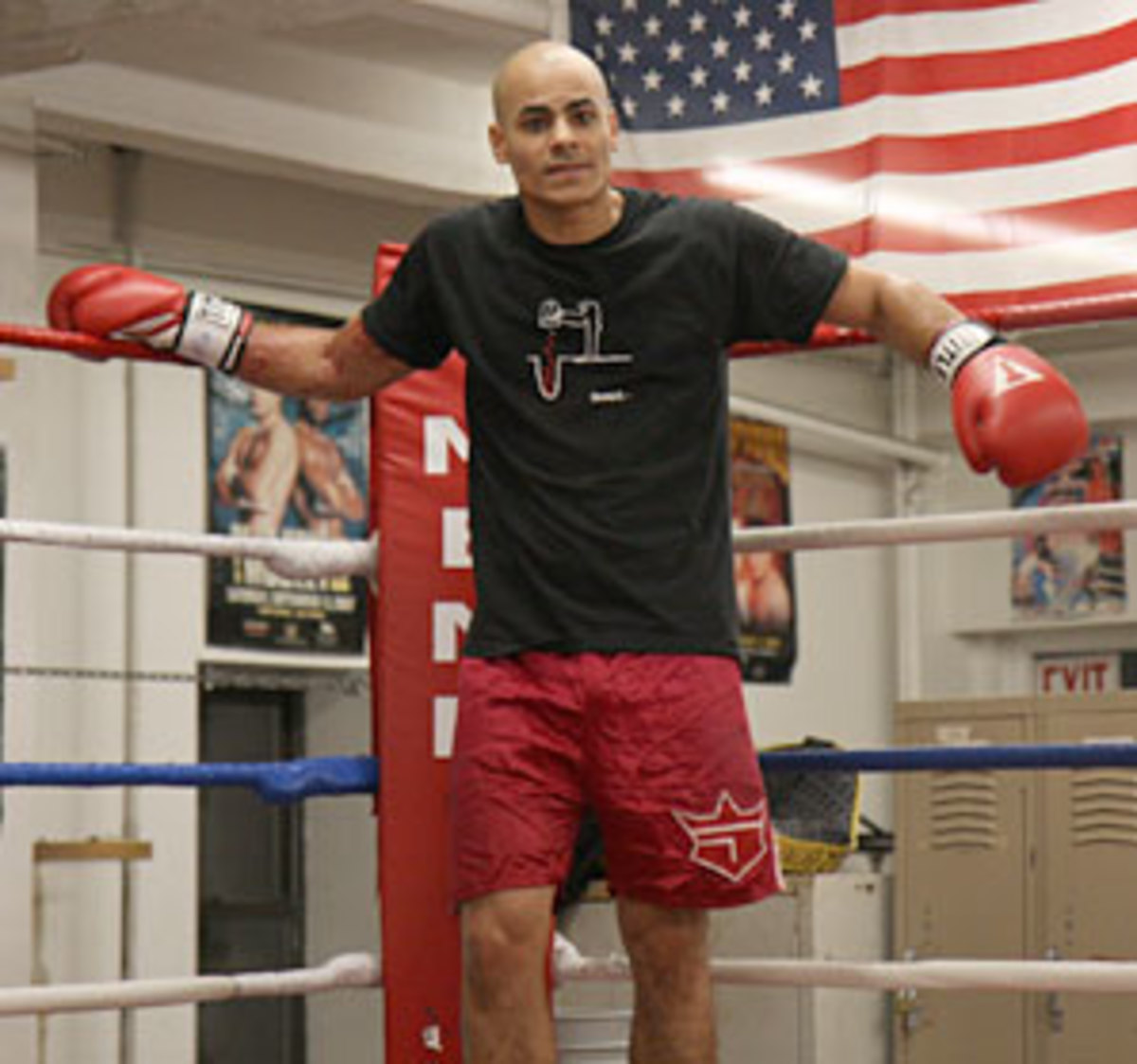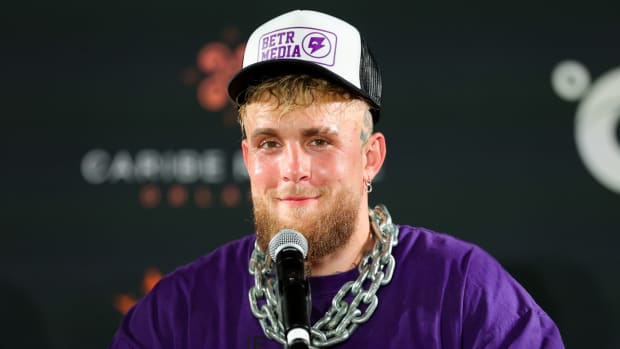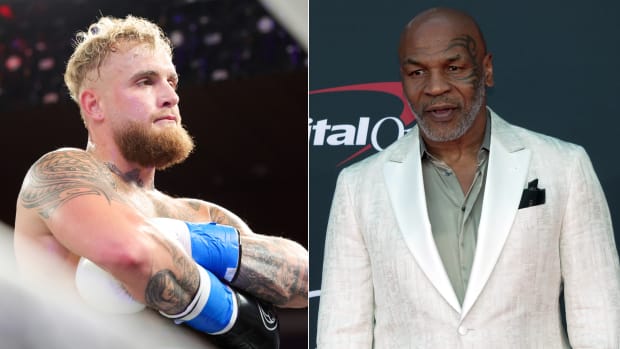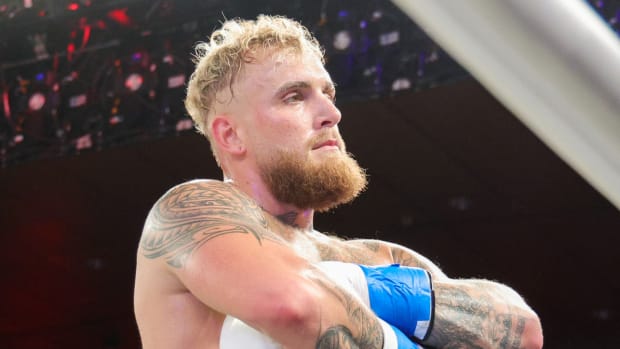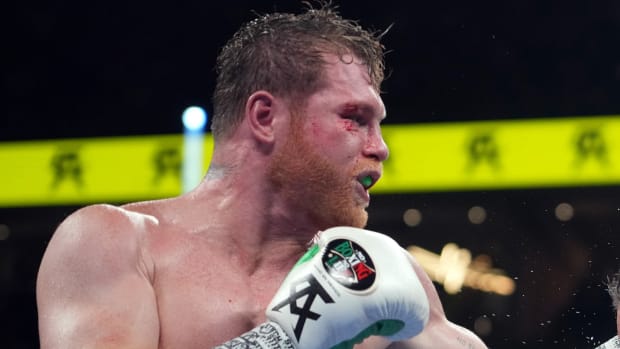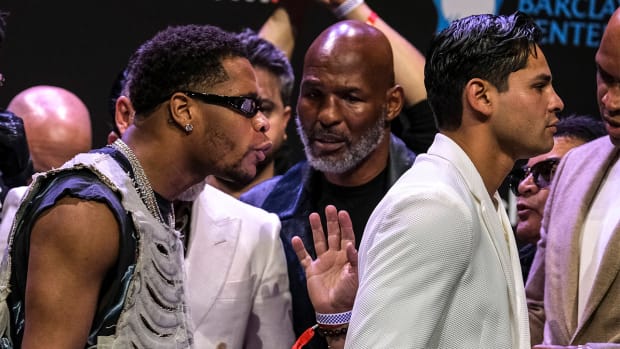Santana's bid to get in contention for world title bout derailed again
In the third round of his NABA junior welterweight defense on Feb. 24, Edgar Santana broke his right hand. In the fourth, the underdog Manuel Perez landed his first major blow on his opponent's face. Within minutes, Santana's right eye had blossomed into a dark purple swelling. Then, in the sixth, under the passive gaze of the ESPN cameras, he broke his other hand. For Santana, fighting the most important clash of his career, this was another in a long line of hiccups.
***
A few months earlier, Edgar "El Chamaco" Santana, a/k/a The Pride of Spanish Harlem, had walked into the Mendez Boxing gym in Manhattan's Flatiron District and approached a duct-taped punch bag. He was compact and wiry, like a tourniquet wound tight. Dipping his left shoulder while he jabbed with his right, he clamped his jaw in concentration.
The walls of the gym were lined with images of famous Latino fighters -- Salvador Sanchez and Julio Cesar Chavez -- intermingled with the giants of the sport who, like Ali and Tyson, require no first name. A clientele comprised of mainly white-collar boxers worked out here weekly. Santana was one of the gym's few remaining pros.
In 2008, Santana was one of the country's most promising light welterweights --with 24 wins and 17 knockouts to his name. ESPN televised his fights and talk of world titles was not unrealistic. But by late 2009, he was behind bars, a convicted drug trafficker.
Since his release from Riker's Island two years ago, Santana had fought twice, both bouts ending in knockouts. In the second, against Omri Lowther, Santana was crowned North American Boxing Association champion. After a Dec. 2 fight was abruptly canceled, with the next step the Feb. 24 fight against Manuel Perez, his comeback was on.
***
Edgar Santana was born in Manatí, Puerto Rico. His parents moved the family to El Barrio in 1986, when he was 7.
"It was definitely rough, a lot of drugs on the street," Santana said, his soft voice barely registering over the background thud of fists hitting bags. "There were people lined up to get drugs. That was a shock."
At his bilingual high school on East 117th Street, Santana was the clown, "always catching the attention of the teachers." He found his calling at 15, when José "Chegüi" Torres, a Puerto Rican light heavyweight, came to speak to students. Santana, already practicing martial arts, decided to switch to boxing.
By 20, Santana had turned pro, but struggled without a manager or promoter, bouncing back and forth between Puerto Rico and East Harlem. He changed trainers frequently, until by 2005 he'd begun to attract enthusiastic headlines. He also opened a barbershop, Santana Cuts, on East 106th St., populating it with a coterie of childhood friends.
"He was on the cusp of his career," said Hector Sarria, a Colombian trainer at Mendez Boxing. "He was close to fighting a world championship fight."
Everything changed on July 18, 2008, when Santana was arrested at his East 102nd Street home. He was weeks from an ESPN-televised fight, but officers of the New York Organized Crime Drug Enforcement Strike Force, listening in on his conversations with two suspected drug traffickers for over a year, had little concern about that.
That morning, Santana emerged from his apartment in handcuffs, wearing a T-shirt emblazoned with one of the many enigmatic slogans of local artist and friend James De La Vega, which now line his barbershop walls: "The pressure of survival in the big city will make you lose sight of your dream. Hang in there."
Accused of brokering a deal to mail a kilo of cocaine from Puerto Rico to New York, Santana posted $150,000 bail. He eventually served four months on Riker's Island, convicted of conspiracy to sell narcotics. He emerged a free man in January 2010.
His arrest and imprisonment affected fans at Mendez Boxing. "It was kind of deflating for everyone in the gym," said patron Mitch McMahon while Santana laid into an Everlast bag, his tongue dangling from his mouth. "You live in the jungle and there are a lot of alligators. The longer you live there, the more likely you are to get bitten."
"Believe none of what you hear and half of what you know," added trainer Joey Gamache. "Boxing's an unforgiving sport."
Santana himself remains cagey about the episode -- "Sometimes you're at the wrong place at the wrong time," he said -- but was more willing to talk about the impact prison had on his physical state. He was well known on Riker's, even respected, but struggled to keep in shape. It was, he said, more of a waste of time than anything else.
Once out, Santana decided to take a break from boxing and focus his attention on the barbershop. But soon he was longing for the ring, and sought out Leon Taylor, a trainer he'd long admired, to orchestrate his comeback. The plan was to challenge for a world title within a year.
"I have the ability to go many places," Santana said.
***
At Santana's barbershop, sandwiched between an aromatic botanica and a Hispanic church, the unprepossessing red awning seems to herald a down-at-heel interior. But De La Vega's Basquiat-meets-Haring scrawls give it a gritty sophistication. Santana points to his favorite inscription, daubed on the shop's white wall: "Your mind has the amazing ability to organize chaos."
With his tight cheekbones and long lashes, Santana doesn't look like your average cauliflower-nosed prizefighter. He dresses differently, too: his jeans tucked into ankle-high boots, the ensemble accessorized with an elegant fedora, complete with feather. He admires Picasso who, Santana says, made people think differently about art.
"I was always a little bit more open-minded about things," he says, displaying his arm as an example. "You've never seen someone with a red sleeve." A red-inked design circles his bicep, a work in progress, he says.
It's a busy afternoon. Carlos Flores walks in with his mother and son. He's just moved to the neighborhood from West Harlem, and wants his beard trimmed before he jets off to Jamaica the next morning. "I'm the subway hero," he says, getting out his phone to display a video of his appearance on the Rachael Ray show.
Last year, Flores jumped onto the 6 train tracks at the 103rd station to save a man who'd fainted, a celebrated act that brought, among other rewards, this free family trip to Jamaica.
Then Antony Marquez, one of the shop's barbers, arrives and greets Edgar knuckle to knuckle. "Jefe," he says in acknowledgment and respect. "No matter how famous he gets," Marquez says of his boss, "he stays in the Barrio and that's why he's loved round here."
Patron Armando Alequin, waiting for a cut, bemoans the decline of boxing in Spanish Harlem. When he was growing up, he says the sport created role models. Boxers, Alequin says, demand respect; they eat well, look after themselves and don't use drugs. "You're a badass but clean cut," he says.
Santana looks nervous at that. "I hope I inspire people, most especially kids," he says. "But I don't know. Being a role model is tricky. There's so many things that come with it, so much expected from you. I can do without that."
***
The brightly lit façade of the Dover Downs Hotel & Casino emerges from an endless ribbon of strip malls and chain motels.
In his room a few hours before the Perez fight, Santana poured himself a coffee and added three brown sugars. This pre-fight ritual left him edgy, but, Santana said, "I like that."
Later, in Santana's locker room, former heavyweight champion Riddick Bowe dropped in to offer his support. "We went through a lot of tough times," said Taylor, trying to lighten the atmosphere as he reminisced with fellow Brooklynite, Bowe. "But we prevailed."
Santana, nibbling on his fingernails, watched impassively. "It's always good to be surrounded by guys like that," he said after Bowe left.
Despite not headlining, Santana was the center of attention. A documentary crew followed his preparations and the press box bristled with anticipation. But most importantly for him, ESPN was broadcasting the event. Nearly four years after the arrest that derailed his last televised appearance, "El Chamaco" could finally say he was back.
Santana emerged in a red sequined dressing gown with a silver trim. His name was emblazoned on the back; a gloved fighter with outstretched arms replaced the "T."
At 139.5 pounds, Santana was one pound heavier than Perez and taller, too. But with his flattened nose and thick frame, the Honolulu-born Perez looked competitive.
The first few rounds were tentative. Perez worked a leaden Santana with disciplined body shots. In the third, Santana swung wildly into nothingness. In the sixth, by which time both Santana's hands were shot, Bowe approached the ring to offer Taylor some advice. Shortly afterward, Santana took a nasty jab to the chin. With four rounds left, Perez was ascendant.
In the seventh, Santana looked to be making headway, drawing blood from Perez's nose. "Keep up with the jab," bellowed Taylor from the corner. But in the eighth, everything changed. Perez landed three decent lefts in quick succession and pinned Santana on the ropes. When the bell rang at the end of the tenth, Santana, his right eye swollen shut, jumped onto the ropes, pumped his arms and attempted to corral the crowd.
The unanimous decision came through: Santana, 94; Perez, 96.
Back in the locker room the mood was grim. Recriminations had broken out. His manager, Brian Cohen, was candid about where the blame lay. "Maybe Leon needs to be a bit more attentive to his training," he said. "This is a huge setback for a guy who is 33. Unfortunately, time is not on our side."
Santana's promoter, Dave Escalet, meanwhile, was quick to praise the impressive Perez. Luck, he concluded, was ultimately not on their side. "Two broken hands. What are the odds of that?"
Santana, slouched despondently in his locker room, was reticent. "I thought I was winning the first rounds," he said through puffy lips. He stared at his disfigured hands. "Let's talk later."
He eventually appeared ringside wearing a black beanie and a strategic pair of sunglasses. After collecting his paycheck, Santana was approached by fans looking to shake his hand. He offered an apologetic forearm in response. In the lobby, Bowe was signing autographs. An inconspicuous Santana walked straight past him and into a waiting elevator. Once again, the comeback would have to wait.
